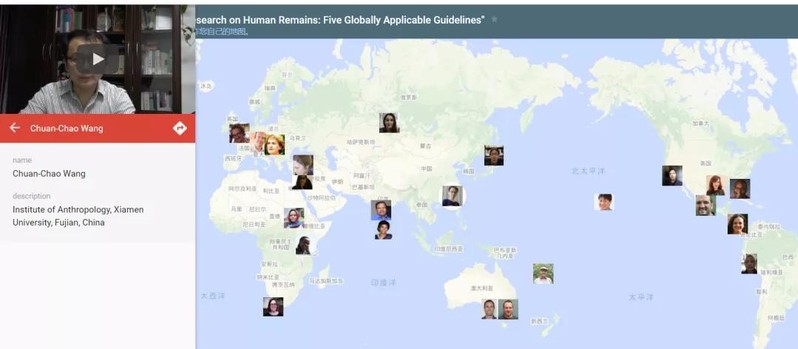On 20 October 2021, Ethics of DNA Research on Human Remains: Five Globally Applicable Guidelines was published in Nature. Wang Chuanchao, professor of School Sociology and Anthropology and School of Life Sciences of Xiamen University (XMU), helped draft the guideline with other 64 co-authors from 31 countries. The research pointed out the problems in the existed ‘North American Guidelines’ and proposed new globally applicable guidelines. Meanwhile, 24-language translations were attached by Nature, wherein the Chinese version was translated by the postgraduate of XMU Liu Yilan and Yang Wenjiao, professor Wang Chuanchao and Wang Qiaomei, member of Institute of Vertebrate Paleontology and Paleoanthropology, Chinese Academy of Sciences.

The first page of the paper with authors' names in alphabetical order by the capital surname
The paper present five guidelines to promote robust ethical standards in ancient DNA research including Central Asia, Siberia, East Asia, Southeast Asia and Oceania. The guidelines address issues of scientific ethics and then return to the topic of ensuring sensitivity of research to perspectives of communities, including Indigenous groups.
(1) Researchers must ensure that all regulations were followed in the places where they work and from which the human remains derived.
(2) Researchers must prepare a detailed plan prior to beginning any study. This should include an articulation of research questions; a description of the techniques to be used and expected impact on remains (including skeletal elements to be studied and quantity to be used); a description of the type of DNA data that will be generated; any plan for material sharing with collaborating laboratories; a timeline for the return of unused material and sharing of results; a plan for how, where and by whom results will be disseminated; a plan for capacity building or training in settings where this can be of value; and a plan for data storage and sharing agreed by stakeholders and complying with open data principles.
(3) Researchers must minimize damage to human remains. Researchers should develop a strategy through consultation with other stakeholders to balance concerns about protecting remains with their scientific analysis. Researchers should not collect human remains without training in best practice techniques to minimize damage while maximizing yield of useable data.
(4) Researchers must ensure that data are made available following publication to allow critical re-examination of scientific findings. Ancient DNA data must be published in a timely manner and subsequently made available at least for the purpose of critical reappraisal of results. Scientists cannot ethically participate in a study if there is not a guarantee that data will be available at least for the purpose of verifying the accuracy of published findings, and this guarantee needs to be incorporated into the original permissions for the study. This is important both to prevent the spread of misinformation, and to enable future analyses that seek to re-examine the same questions.
(5) Researchers must engage with other stakeholders from the beginning of a study and ensure respect and sensitivity to stakeholder perspectives. A project to generate new ancient DNA data may be initiated by diverse stakeholders, including but not limited to local communities, archaeologists, anthropologists, geneticists or curators, any or all of whom may be members of the research team if they contribute in a scholarly way to the work.Other stakeholders who are consulted should be thanked in the Acknowledgments sections of papers if they consent to be named. Stakeholders—ideally including groups from the place of origin of the human remains being studied—should be actively involved in discussions about study design, research questions and whether a scientific project should proceed.

(Harvard Medical School interviewing more than 20 representative scholars from around the world in response to new guidelines through the video.)

